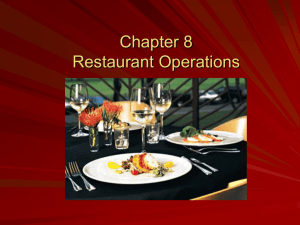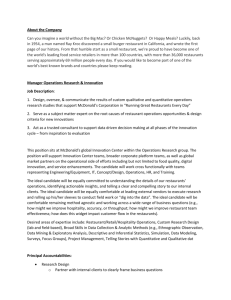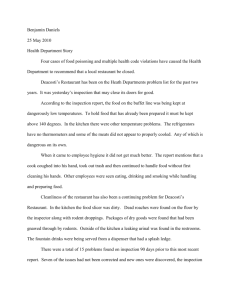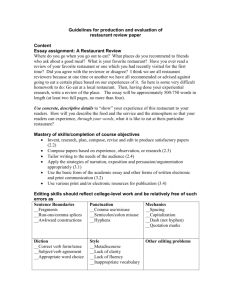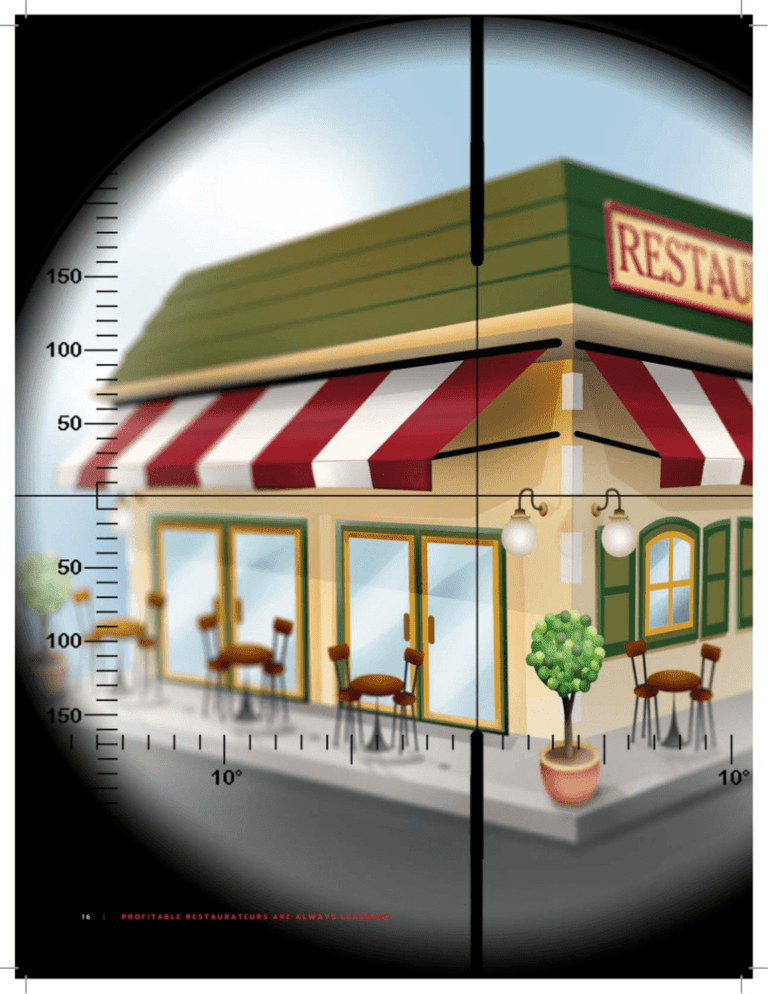
16
|
PROFITABLE RESTAURATEURS ARE ALWAYS LEARNING
Torpedo Alley
10 Bad Financial Practices That Can
Sink Independent Restaurants
Even eliminating one or two of these torpedoes
can increase your take-home returns.
By Jim Laube
G
reat food won’t do it. And neither will impeccable
service or even the best location in town.
Of course, these factors are important, but a restaurant’s success will always be limited unless the owner
is not only a good operator but also knows how to make
their restaurant grow and prosper.
That’s because creating a financially successful restaurant requires business skills and understanding basic
financial concepts and controls. If you don’t master these
skills, you risk finding yourself adrift in a sea of competitors who are gunning for your business.
A common characteristic that we consistently see in
nearly all successful independent operators is that they
understand their numbers (i.e., financial statements and
important metrics). They are relentless in keeping up with
their key costs and margins and they understand the direct
connection between the decisions and activities that take
place in their restaurants and their financial results. They
use their numbers to quickly measure their results so they
know how well or how poorly they’re doing, and if there
are problems where they need to focus their attention.
Understanding your numbers and having good financial practices is the first step in protecting your assets and
understanding your business. It will help you make better
business decisions by relying more on facts contained in
the numbers and less on intuition, suspicions and gut feeling. Following is a list of common mistakes and bad financial practices that are unfortunately quite common among
independent restaurants that can’t seem to sustain an adequate profit, and ultimately brings down their businesses.
1. Not Using Financial
Statements to Measure
Progress and Results
A restaurant’s financial statements are akin to a scoreboard in a football game. Can you imagine two teams
playing the Super Bowl without a scoreboard? Absurd,
I know. The scoreboard shows who is winning and mea-
sures the relative successes and failures of the two teams.
During the game, the ebb and flow of the score affects
strategy, coaching decisions, play calling and ultimately
the activities on the field.
Reading the financial statements of a restaurant should
tell you the same thing. They’ll reveal whether you’re
winning or losing (in terms of profitability) and where
the restaurant is performing well and not so well. Financial statements can help you evaluate your managers’ and
staff’s effectiveness, identify problem areas, show where
you need to focus your attention and help you make better
ongoing decisions.
The financial statements express in monetary terms the
quality of the decisions and activities taking place in your
restaurant. Good results on the financial statements are the
result of good decisions and competent execution in the restaurant. Bad results mean poor decision making and/or execution in the restaurant and should tell you that something
needs to change. It is amazing how many independent operators use the “seat of the pants” accounting methods.
Highly successful independent operators tend to pay
very close attention to their financial statements and other
key numbers. It’s how they measure their progress and results in nearly every area of the restaurant.
Do you want to improve your effectiveness as an owner or manager? Start paying more attention to the numbers on your financial statements and operating reports.
Are they good or bad? Getting better or worse? What are
the activities or decisions that could be causing the bad
results? Using your numbers to identify problems and
weaknesses is the first step in doing a better job of managing or correcting the processes and activities that are
causing subpar results and holding back your success.
2. Using a Generic
Profit-and-Loss Statement
On the next page is a typical “generic” P&L (profit-andloss) format similar to one that many restaurants use.
AUGUST 2013
|
www.RestaurantOwner.com
17
"
BAY STREET GRILL
PROFIT AND LOSS STATEMENT
For The Year Ended December 31, 2012
"
"
SALES
Food
Beverage
TOTAL
"
"
COST OF SALES
Food
Beverages
TOTAL
"
"
"
Bank charges
Building repairs
Cash (over)/short
Cleaning supplies
Complimentary meals
Coupon discounts
Credit card charges
Depreciation
Electrical
Equipment repairs
FICA & other taxes
Group insurance
Interest
Kitchenware
Laundry
Miscellaneous
Music & entertainment
Paper supplies
Payroll
Postage
Printing & office supplies
Professional fees
Property insurance
Real estate taxes
Rent
Royalties to ASCAP
Telephone & fax
Trash removal
Uniforms
Workman’s compensation
TOTAL EXPENSES
"
"
"
"
"
"
"
"
"
"
"
"
"
"
"
"
"
"
"
"
"
"
"
"
"
"
"
"
NET INCOME BEFORE TAXES"
"
"
BAY STREET GRILL"
"
"
"
"
417,992.08"
83,113.21"
501,105.28"
1,099,457.72"
22,943.00"
458.80"
13,485.00"
755.28"
9,215.70"
10,574.82"
7,849.00"
26,889.12"
29,761.90"
28,101.60"
5,348.47"
40,824.91"
19,474.00"
43,430.80"
9,941.80"
13,415.58"
5,949.60"
10,458.80"
15,215.74"
420,875.40"
938.84"
5,487.10"
18,317.37"
27,859.00"
48,258.80"
149,589.04"
3,915.80"
5,881.80"
6,576.00"
5,124.80"
21,885.52"
1,028,803.40"
$ 70,654.31"
$1,302,156.00
298,407.00
1,600,563.00
"
"
GROSS PROFIT"
EXPENSES"
Advertising"
"
"
PROFIT & LOSS STATEMENT
For The Year Ended December 31, 2012
"
"
"
26.1%"
5.2%"
31.3%"
68.7%"
1.4%"
0.0%"
0.8%"
0.0%"
0.6%"
0.7%"
0.5%"
1.7%"
1.9%"
1.8%"
0.3%"
2.6%"
1.2%"
2.7%"
0.6%"
0.8%"
0.4%"
0.7%"
1.0%"
26.3%"
0.1%"
0.3%"
1.1%"
1.7%"
3.0%"
9.3%"
0.2%"
0.4%"
0.4%"
0.3%"
1.4%"
64.3%"
4.4%"
81.4%
18.6%
100.0%
"
Sales:
Food
Beverage
Total Sales
"
"
"
"
Cost of Sales
Food
Beverage
Total Cost of Sales
"
"
"
"
Payroll
Management
Staff
Employee Benefits
Total Payroll
"
"
PRIME COST
"
"
"
"
"
"
CONTROLLABLE INCOME
"
"
Non-Controllable Expenses:
Occupancy Costs
Depreciation & Amortization
Total Non-Controllable Income
"
"
"
Restaurant Operating Income
Interest Expense
"
Income before Income Taxes
Now compare this “generic” P&L to one based on the
"
"
"
81.4%
18.6%
100.0%
"
"
"
417,992
83,113
501,105
"
"
"
32.1%
27.9%
31.3%
"
"
"
"
"
"
"
994,165 "
"
"
"
$ 1,302,156
298,407
1,600,563
150,500
270,375
72,184
493,059
Other Controllable Expenses:
Direct Operating Expenses
Music & Entertainment
Marketing
Utilities
General & Administrative Expenses
Repairs & Maintenance
Total Other Controllable Expenses
"
"
"
"
"
"
"
"
"
"
"
"
377,993 "
70,941
14,375
35,057
41,256
57,943
8,833
228,405
"
"
"
114,085 "
43,431 "
$ 70,654 "
234,146
29,762
263,908
"
"
"
"
62.1% "
9.4%
16.9%
4.5%
30.8%
"
"
"
"
"
"
"
23.6% "
4.4%
0.9%
2.2%
2.6%
3.6%
0.6%
14.3%
"
"
"
7.1% "
2.7% "
4.4% "
14.6%
1.9%
16.5%
3. Basing Food and Beverage
Although
the
sales and
expenses
are the same,
Now
compare
this “generic”
to one
based
on the
National
Restaurant
National
Restaurant
Association’sP&L
Uniform
System
of AcCost
Percentages
On Association’s
‘Total’
Salesthere is a• The USAR giv
lot
more
useful
information
on
the
USAR
version
that preparing and
counts for
Restaurants
(USAR) at for
the right
of the page:(USAR):
A restaurant operator once approached me
at a workshop
Uniform
System
of Accounts
Restaurants
helpwanted
betterto know
understand
this wasn’t
restaurant
is
Although the sales and expenses are the same, there is a can
lot and
why hishow
restaurant
more profitperforming.
Here
are
just
a
few
of
the
advantages
of
• or
more useful information on the USAR version that can help able given that his food cost was consistently 28 percent
[image
2]
using
the
USAR
format:
you better understand how this restaurant is performing. Here less. He showed me his P&L, and the cost-of-sales percent• Similar
expenses
are like
grouped
into meaningful
are just a few of the advantages of using the USAR format:
ages looked
something
this:
categories such as payroll, direct operating expenses,
• Similar expenses are grouped into meaningful categories such
as payroll, direct operating expenses, marketing and utilities.
marketing and utilities.
• Prime cost, the total cost of sales and payroll, and•onePrime
of
cost, the total cost of sales and payroll, and one of
the most important operating benchmarks in a restaurant,
the most important operating benchmarks in a
is shown clearly on the statement.
restaurant, is shown clearly on the statement.
• Another important operating ratio, Controllable Income,
• Another important operating ratio, Controllable Income,
often used as a margin to evaluate management’s effecoften used as a margin to evaluate management’s
tiveness, is also calculated and presented.
effectiveness, is also calculated and presented.
• Makes it easy to compare a restaurant’s key costs, margins
• Make it easy to compare a restaurant’s key costs,
and ratios with other restaurants and industry averages.
margins and ratios to other restaurants and industry
• The USAR gives you a financial reporting “system” for
As you can see, each of the cost-of-sales percentages were
averages.
preparing and presenting your financial results that has based on “Total” Sales, not the food (or beverage) sales that
been proven in tens of thousands of restaurants.
correspond to food (or beverage) costs. Food cost (as a per• The USAR was developed by the National Restaurant Associ- centage of food sales) was actually closer to 35 percent.
ation and was recently updated in 2012. It is endorsed by ResWhen shown individually, food and beverage cost pertaurant Startup & Growth and RestaurantOwner.com. For
centages
[image
3] should always be based on their corresponding or
more information, visit www.RestaurantOwner.com/USAR. respective sales amounts, not total sales.
18
|
been proven in
The USAR wa
Association an
endorsed by
RestaurantOwn
www.Restaura
3
Basing Food
‘Total’ Sales
A restaurant
workshop and
wasn’t more p
consistently 28
and the cost-of
this:
PROFITABLE RESTAURATEURS ARE ALWAYS LEARNING
#"
"
"
6484
CAN’T.
CAN.
Lowest cost per ounce
for Heinz ® Ketchup.
Easy and safe
to open.
90% less packaging
by weight.
Serve the ketchup your
guests prefer 5-to-1 versus
any other brand.*
To learn more about the value of America’s Favorite Ketchup®
in a #10 pouch, go to www.heinzpouch.com.
* Source: Datassential Consumer Preference Survey, February 2011.
© H.J. Heinz Company, L.P. 2013. All rights reserved.
64843_65166-Heinz-RS&G_rt.indd 1
5/23/13 2:51 PM
Sometimes accountants unfamiliar with restaurant accounting may recommend the cash basis of accounting to their restaurant clients because their clients in other industries use it.
Restaurants need financial statements that reflect sales when
they are earned regardless of when the cash is collected and
that reflects the amount of costs and expenses incurred regardless of when the invoices are ultimately paid. This is the only
way to get an accurate picture of sales, expenses and profit.
4. Not Taking Account Beginning
and Ending Inventory When
Calculating Food and Beverage Costs
When inventory values are ignored, food and beverage costs
reflect the amount of food and beverages “purchased” during
the month. Food and beverage costs should show the amount
of product actually “used” during the reporting period, not the
amount of product purchased. To do this, a physical inventory
needs to be conducted at the end of the period to determine
the dollar value of the food and beverages that were purchased
but remain on the shelf and not consumed. One reason chain
restaurants are generally more profitable is because they do a
better, systematic measurement of their inventory.
As shown below, food cost based on purchases can be materially different from the amount of food actually used when the
amount of product on hand at the beginning of the period is much
more or less than the amount on hand at the end of the period.
6. Food, Beverage and Labor Costs
are Calculated Monthly
The most profitable restaurants we work with calculate
and report their food, beverage and labor costs, commonly
referred to as Prime Cost, not just at the end of the month on
their P&L, but also at the end of each week.
They do it weekly for several reasons. First, food, beverage
and labor costs are the biggest and most difficult to control costs
in a restaurant. If there is a cost control problem, chances are
very high that it’s going to involve at least one of these three
costs. If there’s a problem, they know about it quickly and can
respond accordingly, as opposed to waiting weeks for the P&L.
Weekly Prime Cost reporting also creates greater staff
awareness and accountability, especially in the kitchen. Chefs
and kitchen managers know that every seven days they’ll find
out what their food cost was for the week. This helps to keep
portion control, inventory management and other food cost
controls at the forefront of the minds of kitchen personnel.
Restaurants that adhere to weekly Prime Cost reporting
almost always have lower food, beverage and labor costs, often by as much as 2 percent to 4 percent of sales, compared
with restaurants that don’t. It’s the old adage: What gets measured gets managed and what gets managed improves.
7. Bookkeepers are Allowed to Handle Cash
Some operators say that they don’t conduct physical inventories because they claim their inventory levels do not
deviate much during the month, so the effect on food cost is
not material. While this may produce satisfactory results in
some operations, our experience has shown that restaurants
that take the time to conduct accurate physical inventories
and use the value of their beginning and ending inventory
to calculate food and beverage costs tend to do a better job
of controlling their food cost than restaurants that don’t.
5. Financial Statements are
Based On Cash Basis Accounting
Cash basis accounting, the practice of only recording
sales when cash is received or expenses when they are paid,
should never be used in a restaurant.
Instead, restaurants should always use the “accrual” basis of accounting. Accrual basis means that sales are recorded when the services or products are sold and costs and
expenses are recorded when products are received and services rendered regardless of when they are paid.
20
|
PROFITABLE RESTAURATEURS ARE ALWAYS LEARNING
There aren’t many absolutes in the restaurant business
but if there is one this is it: “No matter how long someone
has been with you, no matter how much integrity you think
they have, never, ever, let anyone who has access to your
accounting records handle cash.’
Unfortunately many restaurant owners have had to learn this
the hard way when they finally discovered that their most loyal
and trusted employee, the bookkeeper, had been embezzling
funds for years. Even family members can believe they have an
inherited right to use company funds. It is always a difficult situation but one has to only look at the financial pages to see almost
every day a company that’s been exposed to this kind of fraud.
This often happens when one of the bookkeeper’s responsibilities is to prepare the daily sales report and deposit slip and
take the deposit to the bank. When this happens the bookkeeper has control of assets (read: cash) and the accounting records.
This makes it very easy for a dishonest person to take cash
out of the deposit and cover it up in the books. Unless there is
some type of ongoing audit function conducted by a different
individual, which there usually isn’t, this problem can go on for
years as long as the bookkeeper doesn’t get too greedy.
The point is this: Bookkeepers should never have access to cash, inventory or any other assets of the restaurant.
Closing managers or someone other than the bookkeeper
should prepare the daily sales report and deposit and take
the deposit to the bank.
8. Transactions In the Restaurant’s
Checkbook and Accounting Records
are Not Reconciled
In other words, no one is preparing monthly bank reconciliations. It’s hard to believe but it happens and always leads
to problems. Recently a restaurateur we know discovered
that his checking account had not been reconciled for three
months because he’d trusted the in-house accountant. That
accountant had gotten behind in other areas and simply let
the checking account rise thinking she’d catch up. It came to
light after the owner noticed that something didn’t seem right
with the balances. This is a basic accounting function.
Bank reconciliation is simply the process of verifying that
your deposits, checks and other transactions in your restaurant’s
checkbook and accounting records match the transactions in
your bank account. Typically a bookkeeper or accountant goes
through the bank statement each month and verifies that each
cash transaction in your restaurant was accurately recorded by
the bank and inspects the bank statement for any unauthorized debits, payments or withdrawals out of the account. Any
exceptions are immediately investigated and resolved.
The reason this is important is that even in our electronic,
automation-driven age, banks can still make mistakes. In
our business, we’ve had instances of missing credit card
deposits, erroneous fees charged to our account as well as
checks recorded twice or for the wrong amount.
If one of your deposits was missing or your bank slipped
up in some other way, how would you know? Unless you or
someone on your staff is reconciling your bank accounts
every month, you probably wouldn’t have a clue.
If you’re not sure whether your bookkeeper or accountant is faithfully reconciling your bank accounts, find out
now. Ask to see your latest bank reconciliations. If you get
a deer-in-the-headlight stare or the last time was June 2010,
you may want to make some changes.
9. Not Reporting 100% of Sales
First, skimming is against the law and the penalties are
extremely severe if you’re ever caught. The government gets
extremely testy about tax evasion so they’ve made it a felony offense with significant fines and even jail time it you’re
convicted. And there are more reasons.
Nearly all meaningful controls are lost in restaurants that
skim. Financial statements and most operating reports are
essentially worthless. Operating percentages and cost ratios
don’t mean anything. Skimming negates the value of inventory controls. It’s next to impossible for managers to know
if they’re doing a good or bad job of controlling expenses
and whether the business is improving or deteriorating fi-
nancially. It’s also very difficult, if not impossible, to run
the restaurant like a business and make intelligent decisions
when sales are consistently and intentionally understated.
No matter how hard owners may try to hide it, one or more
employees at some point are going to figure out what’s going on. When they do, they may feel entitled to some of the
spoils. This makes it easier for them to justify taking home
a few boxes of meat or pocketing a couple of $20 bills out of
the till. Some employees have been known to blackmail the
operator if they’re aware that skimming is a serious violation of the law. Probably most important, though, is operators
who skim lack any moral authority and credibility. Integrity
is an important issue for many employees and they don’t respect or want to work for someone who cheats.
Finally, skimming makes a restaurant more difficult to sell.
Pocketing cash off the top dramatically lowers the value of the
business. Business valuations are heavily dependent on accurate, credible financial information being available. When it’s
not, there’s nothing to justify or prove how high the sales volume is and how much profit the business is actually making.
10. Employees are Kept In the Dark
We believe that restaurant employees should know that they
work in a low-margin business. They won’t instinctively figure
this out unless they’re told. To validate, just ask a few restaurant employees how much money they think the owner makes
and they’re likely to say “a lot.” That’s because employees see,
what many believe to be, large amounts of cash coming into
the restaurant every day but have no concept of what it costs to
operate a restaurant and how much profit remains after all the
expenses are paid.
Many operators take the time to educate their employees on
the low-margin nature of the restaurant business. Some do this
by conducting an employee meeting and giving everyone 100
pennies. The employees are told the 100 pennies represent a
dollar in sales and they’re going to be shown out of every dollar
of sales what it costs each month to operate the restaurant.
The employees are asked to pay 30 pennies for the food and
beverage vendors, 32 for payroll and payroll taxes, 3 cents for
utilities, 6 for rent and so on. After all the expenses are paid,
the remaining pennies represent the amount of profit the restaurant earned. Whether there are 3, 5 or even 10 pennies
left, it’s a whole lot less than most employees assumed.
Now the employees have a basic understanding of the
little things, like exact portioning, reducing waste and the
hundreds of other seemingly meticulous steps a restaurant
must take to control costs and have a shot at making a profit.
At least some of them will realize the restaurant is not the
moneymaking machine they may have thought.
You might use the 10 financial practices as a checklist to
evaluate how you’re doing in managing the financial aspects
and areas of your business. The good news is that eliminating even one or two of the bad practices addressed here can
go a long way to making you a more effective owner and
your restaurant a more profitable and valuable business. RS&G
AUGUST 2013
|
www.RestaurantOwner.com
21


